 |
|

|
 |
TABLE of CONTENTS
 |
Mn/DOT to honor fallen workers |
|
Darrell Blackwell, from the Sleepy Eye truck station in District 7, was operating a mower on Hwy 4 near Fairfax last October when his vehicle collided with a semi-trailer truck. He was killed instantly.
Blackwell was the 30th Mn/DOT employee to die on the job since 1960.
Blackwell and other Mn/DOT employees who have been killed or injured while working will be remembered during observances held statewide during the next few days in honor of Workers Memorial Day.
Because Workers Memorial Day (April 28) falls on a Saturday this year, it will be observed at Mn/DOT on the following dates:
- District 1 - April 26, Duluth and Virginia
- District 2 - Will observe throughout the week
- District 3 - April 26, as part of Employee Day at Camp Ripley; lieutenant governor will attend
- District 4 - April 26, Detroit Lakes
- District 6 - April 30, from 8:30 to 9:30 a.m., Rochester
- District 7 - April 30, Mankato
- District 8 - April 26, Willmar
- Metro District - April 26, 7:30 p.m., Camden truck station; lieutenant governor will attend
- Central Office - April 27, lieutenant governor’s message will be played at 2 p.m. over the building’s public announcement system
For more information about work zone safety, see: http://www.dot.state.mn.us/workzone/index.html. |
 |
|

|
 |
TABLE of CONTENTS
 |
Forming transportation policy of tomorrow headlines national commission hearing |
By Jeanne Aamodt
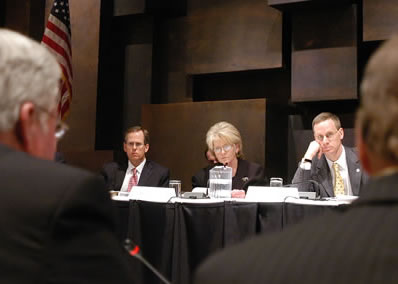
U.S. Secretary of Transportation Mary Peters and National Surface Transportation Policy and Revenue Study Commission members listen to testimony from regional transportation leaders. Photo by David Gonzalez |
Area transportation leaders discussed the future of U.S. transportation policy April 18 at a field hearing of the National Surface Transportation Policy and Revenue Study Commission.
Held at the University of Minnesota Twin Cities campus, the field hearing took testimony on the topics of traffic safety, the roles of rural areas and local governments, recommendations for a new national transportation policy, congestion solutions and freight user perspectives and ideas.
Participants included U.S. Secretary of Transportation Mary Peters, officials from the Minnesota, Montana, North Dakota and South Dakota departments of transportation and representatives from 3M, Target, General Mills, Cargill and Medtronic.
In her testimony, Lt. Gov./Commissioner Carol Molnau said that the nation’s resources should be directed at preserving the Interstate and National Highway System infrastructure; improving highway safety and reducing fatalities; reducing urban congestion; improving state and local connections to the Interstate and National Highway System; and removing freight bottlenecks and improving freight mobility.
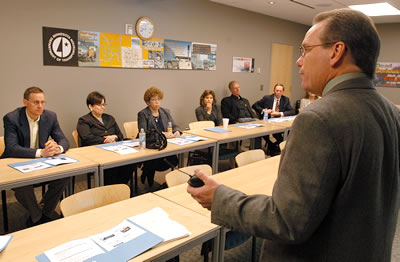
Bernie Arseneau, Traffic, Safety and Operations director, led commission members on a tour of Mn/DOT’s Regional Transportation Management Center, the MnPASS I-394 Express Lane and Hwy 100 in St. Louis Park. Earlier, he testified before the commission regarding congestion management and mitigation methods used in Minnesota. Photo by David Gonzalez
|
“If national policy is clearly and keenly focused on these five priority programs – and federal funding is increased to adequately support each area’s performance-based goals – the nation will realize a dramatic improvement in national mobility, safety and economic productivity,” she said.
Molnau also called for a federal mileage-based user fee system to replace the existing gas tax.
“Oregon, Washington and Minnesota are evaluating the technology necessary for a mileage-based user fee, but the states can’t do it alone. We will need a national up-to-date system to meet future transportation funding needs,” she said.
Jim Lynch, director of the Montana DOT; Francis Ziegler, director of the North Dakota DOT, and Judith Payne, secretary of the South Dakota DOT, all spoke for a strong federal investment in both the rural and urban United States.
“We rural states have large land areas and low populations. Yet, we are like the Saudi Arabia of agriculture – we provide food for the world in American's heartland and help balance trade. We are exporting massive amounts of agricultural products and are seeing increased ethanol production. Because of poor air service and limited or no rail service, we are highway-dependent,” said Secretary Payne.
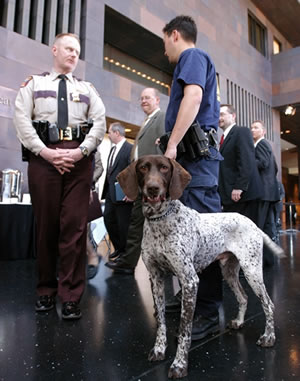
The field hearing was interrupted for about 45 minutes during the afternoon after the University of Minnesota received a bomb threat that evacuated several buildings across campus. A bomb-sniffing dog in the lobby of the McNamara Alumni Center, where the hearing was held, is ready to lend a nose as needed. Photo by David Gonzalez |
Mn/DOT and the University of Minnesota Center for Transportation Studies hosted the day-long event.
The Minnesota hearing was the last national hearing scheduled by the commission. According to Brad Larsen, Mn/DOT's federal relations manager, the commission will now begin the work of preparing recommendations for a new national transportation policy. The recommendations will be presented to Congress in December 2007.
"Many transportation stakeholders are hoping that the commission’s recommendations will play a role similar to that of the Clay Commission whose recommendations of 50 years ago resulted in the development of the Interstate Highway System,” Larsen said.
Larsen also said the work of the National Surface Transportation Policy and Revenue Study Commission and a new national transportation policy will be the focus of this year’s regional AASHTO meeting, the Mississippi Valley Conference, which will be held in Minneapolis July 9-11.
A copy of the lieutenant governor’s testimony is posted on Mn/DOT's Web site at http://www.dot.state.mn.us/govrel/2007hearing/testimony.pdf.
Testimony of other witnesses will be available online on the commission’s Web site. For more information, visit www.transportationfortomorrow.org.
|
 |
|

|
 |
TABLE of CONTENTS
 |
Rallies stress need for motorists, cyclists to ‘share the road’ safely |
|
By Craig Wilkins
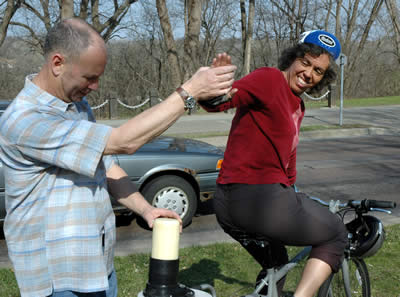
Mn/DOT’s Gabriella Tsurutani exchanges high-fives with Gary Hendlin after making a smoothie with a bike-mounted, pedal-powered blender during a Share the Road event in Minneapolis. Tsurutani, an information technology specialist 4 in Decision Support, is an avid biker; Hendlin chairs the Longfellow Community Council’s committee on the environment and transportation. Photo by Craig Wilkins
|
Sometimes being between a car and a bicycle is a hard place indeed.
That’s especially so in urban areas like the Twin Cities where drivers and bicyclists converge in large numbers on streets and parkways popular for local, recreational and commuter travel.
Routes such as historic Summit Avenue and the East River Road in St. Paul and the West River Road in Minneapolis attract a mix of commuters, local residents and tourists.
On April 20, Mn/DOT and its partners took the Share the Road Program to those areas to promote safe and respectful interaction between motorists and bicyclists.
Staff from Transit’s Bike/Pedestrian Section joined neighborhood organizations, public agencies and the State Bicycle Advisory Committee to engage neighborhood residents and push for safer driving and biking behaviors.
At the Longfellow neighborhood in Minneapolis, Bob Works, section director, joined elected officials and community leaders to promote safety messages.
Works said roadways such as Summit Avenue and the parkways reflect the essence of the neighborhoods they pass through.
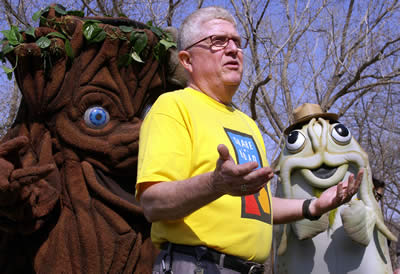
Flanked by Elmer the Elm Tree and Freddie the Catfish, Mn/DOT’s Bob Works speaks at 27th Street and the West River Parkway during the event. Works is the director of the Office of Transit’s Bike/Pedestrian Section. Elmer represents the Minneapolis Park Board; Freddie serves as the mascot for the U.S. Park Service. Photo by Terry Faust
|
“Sharing the road is a local as well as a statewide concern,” Works said. “Neighborhood initiatives are an effective way to address this issue.”
In attendance were Girl Scouts holding ‘slow down’ signs, neighborhood residents and dozens of bikers who left the parkway to join the activities.
At one location, members of a bicycle cooperative invited people to pedal a stationary bike and make their own foot-powered smoothies. A huge, bike-powered snail crept by to remind people to slow down.
“A friend of mine once said, ‘I hate cars when I’m biking and I hate bikes when I’m driving,’” said Gary Hendlin, chair of the Longfellow Community Council’s committee on the environment and transportation.
“We all need a paradigm shift in behavior and attitude,” he said. “Motorists need to drive at reasonable speeds; we all need to follow the rules of the road such as keeping at least three feet of space between cars and bikes and following traffic rules.”
Mn/DOT and the State Bicycle Advisory Committee initiated the Share the Road campaign in 2005.
|
 |
|

|
 |
TABLE of CONTENTS
 |
Hwy 10/Connect Detroit Lakes realignment project enters next phase |
By Judy Jacobs, District 4 public affairs coordinator
The ice may still be on Big Detroit Lake, but that won’t slow down the crews on the Hwy 10/Connect Detroit Lakes realignment project, now in its second year of construction.
Groundbreaking ceremonies for this season’s work were held April 19 with representatives from Mn/DOT District 4, the city of Detroit Lakes, Becker County, Detroit Lakes Regional Chamber of Commerce and U.S. Sen. Norm Coleman’s office in attendance.
“The project is the largest undertaking in Mn/DOT District 4 history,” said Lee Berget, District 4 transportation engineer. “With a total project cost of just over $60 million, project development and delivery in seven short years is a credit to the men and women of District 4 and all the support they got from our Central Office staff.”
Berget also recognized Dick Stehr, former Mn/DOT Engineering Services Division director, who now represents the consultant on the project, HNTB. Special thanks went to Burlington Northern Santa Fe Railway, Canadian Pacific Railway, Becker County, the city of Detroit Lakes and several local individuals and agencies who provided input and served on committees along the way.
Intended to improve safety and mobility along the Hwy 10 corridor, the project this year will include:
- Reconstruction and realignment of approximately three miles of Hwy 10
- Realignment of the BNSF railroad tracks
- Construction of a Roosevelt Avenue underpass of Hwy 10
- Reconstruction of approximately one-half mile of Hwy 59 between Hwy 10 and Hwy 34
- Construction of a frontage road around Big Detroit Lake from East Shore Drive to downtown Detroit Lakes
One of the first tasks will be to move the railroad tracks to the new alignment in May.
“The BNSF will bring their track laying machine to Detroit Lakes,’’ said Shiloh Wahl, project engineer. “It has the capability of laying 4,000 feet of concrete ties and rails each day which will finish laying the track in a week.”
Crews will remove the old track and will continue work on the underpass, including installing a drainage system capable of handling a 50-year flood.
In addition, two-lane Hwy 59 will be expanded to four lanes plus a turn lane to increase efficiency and reduce traffic congestion. At the same time, crews will construct a new Hwy 59 bridge over the railroad tracks near the Hwy 10 intersection. A frontage road along Hwy 10 and Big Detroit Lake is also planned.
Last year, crews completed the Hwy 59/34 intersection and a portion of the Roosevelt Avenue/Hwy 10 underpass. Railroad grade construction on Hwy 10 also began last year and included construction of a new railroad bridge over the north portion of the new Roosevelt Avenue underpass.
For more information, or to follow the progress of this project, visit the Web site at www.dot.state.mn.us/d4/projects/connectdetroitlakes.
|
 |
|

|
 |
TABLE of CONTENTS
 |
National conference focuses on how to do winter highway maintenance better |
|
By Craig Wilkins
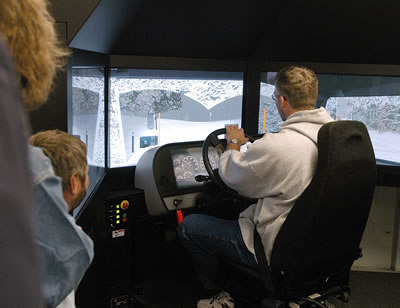
A conference participant tries the snowplow simulator that the Iowa DOT uses to train operators. Brian Miller, an IDOT trainer, said his department has used the simulator to improve the skills of more than 1,000 employees. Photo by David Gonzalez |
At first, seeing an architect using a driving simulator for training snowplow drivers seemed a bit odd.
Asked why she was interested in plow operations, Terry Olsen said, “I design public works facilities. I need to know what’s important to you all so that I can consider those factors in my work.”
Enough said.
Olsen, a St. Paul consultant, was among more than 2,000 participants at the American Public Works Association’s winter maintenance conference held April 22-25 in St. Paul.
The conference brought managers, supervisors, operators, researchers and policy makers together to share what they know and, like Olsen, to learn more about what they need to know.
The exhibit hall featured roundtables designated for informal discussion about subjects such as alternative fuels, emergency management and climate change.
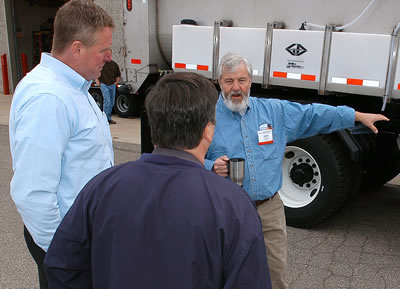
John Scharffbillig, fleet manager, Maintenance, explains features of a newly completed snowplow to participants in the American Public Works Association Conference. Tours included this one to the Central Services facility at Fort Snelling where truck chassis are outfitted for use as snowplows. He said more than 200 conference participants visited the facility and its display of winter maintenance equipment. Photo by David Gonzalez |
The conference offered an international perspective with participants and speakers from several states as well as Canada, France and Great Britain. Mn/DOT and Minnesota cities and counties also were well-represented at the conference.
Participants heard experts in winter road maintenance, joined hands-on workshops and toured nearby facilities such as the Regional Transportation Management Center in Roseville and Central Services at Fort Snelling.
“One of the hottest topics here is using liquid de-icers, but we can learn about subjects that range from new shovel racks to sophisticated management systems,” said Bret Hodne, chair of the APWA’s subcommittee on winter road maintenance and the public works director for West Des Moines, Iowa.
Hodne said there was also strong interest in tests using rubber and steel-carbide plow edges now being tested by Mn/DOT and many other agencies.
He said the conference, for example, enabled early innovators in liquid de- icers to see how their work has changed current practices and may affect future operations.
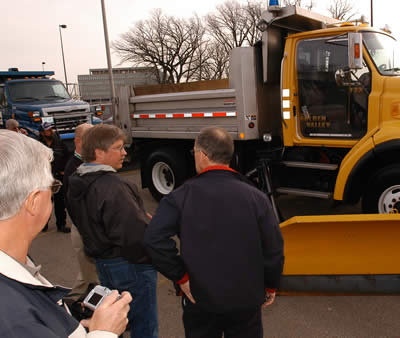
A snowplow with a plastic door gives operators a clear view for gauging the distance between their plows and parked cars in urban areas. The city of Golden Valley uses the plow. Photo by David Gonzalez |
Gordon Regenscheid, Mankato’s assistant district engineer for maintenance operations, said he was anxious to share what he learned with district maintenance staff who have earned a reputation for innovation and inventiveness.
District 7 staff did pioneering work with liquid de-icers; district employees are now testing products such as laser-guided direction for snowplow operators and flexible, plastic containers for liquid chemicals that were featured at the conference’s exhibition area.
Duluth/District 1’s test of Clear Lane, a pavement containing de-icing chemicals which are automatically released by icing and other conditions, drew a high level of interest at workshops sessions.
Rick Shomion, training coordinator with Maintenance, said the conference and the recent Spring Maintenance Expo in St Cloud provided peer-to-peer discussions about the most effective equipment, products and practices.
“With budgets shrinking, maintenance managers are looking for innovative ways to do things, but may be reluctant to try something new and risk a costly failure,” Shomion said. “Here at this conference, they can get direct feedback about what works and what doesn’t.”
|
 |
|

|
 |
TABLE of CONTENTS
 |
Center for Transportation Studies honors Donna Allan’s contributions to transit |
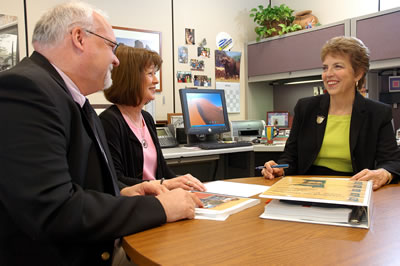
Office of Transit employees Tom Gottfried and Judy Ellison meet with Donna Allan, Transit director, in her office. Photo by David Gonzalez |
Donna Allan, transit director, recently received the Ray L. Lappegaard Distinguished Service Award for her leadership in the field of transit.
The award was presented by the University of Minnesota’s Center for Transportation Studies.
The honor recognizes Allan’s contributions in transit, including her role in support of the state’s Interagency Committee on Transit Coordination. Gov. Tim Pawlenty established the panel in 2005 to improve the coordination and delivery of transit services in the state, particularly for low-income people, the elderly and people who have disabilities.
The award also cites Allan’s overall leadership, mentoring others in the field and supporting members of the transit profession. She has served in other leadership roles with organizations such as the American Association of State Highway and Transportation Officials and the Women’s Transportation Seminar.
Allan has been Mn/DOT’s transit director since 1993. During her tenure, public transit services have expanded to include service in 74 of the 80 counties outside the Twin Cities metro area.
She has worked for Mn/DOT since 1976.
CTS presents the annual award in memory of the late Ray Lappegaard, a former Mn/DOT commissioner and state legislator who led the center’s executive committee from 1989 until his death in 1993.
|
 |
|

|
 |
TABLE of CONTENTS
 |
Design-build program continues to receive recognition |
By Donna Lindberg
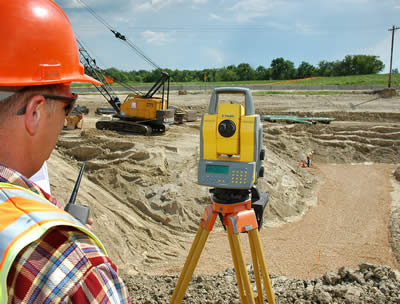
A contractor surveys for utility work on the Hwy 212 project near Pioneer Trail in Eden Prairie last summer. Photo by David Gonzalez
|
Minnesota was one of three states to receive a 2007 winner of the Design-Build Institute of America’s “Transportation Owner of the Year” Award during the 2007 Design-Build in Transportation Conference in Minneapolis last week.
“This award recognized Mn/DOT for its contributions in advancing the awareness, understanding and use of design-build as a project delivery method,” said Jay Hietpas, Mn/DOT’s design-build program manager.
The Hwy 212 design-build project also was selected to receive a Federal Highway Administration 2007 “Excellence in Project Management and Accommodation Award” for projects over $100 million. This award will be presented during the AASHTO Right of Way and Utility Conference on April 30.
“One of the critical challenges facing our industry is providing context-sensitive transportation solutions to meet the public’s mobility needs, while considering the needs and desires of our communities and stakeholders. Your project along with the other 2007 utility award winners illustrate (that) transportation providers and our industry partners at the local, state and regional levels have embraced this challenge with resounding success,” Dwight A. Horne, FHWA Program Administration director, wrote in a letter to Jon Chiglo, Hwy 212 project manager, and Scott Risley, of Zumbro River Constructors.
“A lot of hard work went into the coordination of utility relocations on this project,” said Chiglo. “This award shows how well ZRC and Mn/DOT have worked together and everyone involved in the utility process should be proud of this achievement.”
“Our receipt of these awards wouldn’t have been possible without our project partners and other states,” said Hietpas. “Our success with this method came out of an exchange of ideas that helped us improve our design-build best practices.”
Added Lt. Gov./Commissioner Carol Molnau, “We are proud of our design-build program in Minnesota and expect to continue to use it on projects that help Minnesotans travel better, faster and safer.”
|
 |
|

|
 |
TABLE of CONTENTS
 |
Machine-control technology reaps rewards, attention |
By Donna Lindberg
Mn/DOT’s Machine Guidance and Automatic Grade Control technology was recently recognized as a 2007 Focus Technology by the AASHTO Technology Implementation Group. The honor identifies “ready-to-use” technological innovations that state and local departments of transportation can transfer to other states.
With “machine control,” global positioning system satellites transmit information to three-dimensional computer models that help operators move earth with greater precision to ensure a smoother driving surface.
“In some cases, the machine controls the earth-moving and the operator simply drives down the roadbed,” said Lou Barrett, transportation program supervisor, Office of Technical Support.
Mn/DOT has used machine control on more than 20 road and off-road projects since 2001.
“With machine control, fewer machine passes are required and work can be done 24/7 with minimal lighting,” Barrett said. “All this can help save time and money result in lower bid pricing on construction projects.”
Machine control can also help improve safety.
“With more projects being done under traffic, placing fewer stakes reduces the risk to construction and survey crews working adjacent to moving vehicles in work zones,” Barrett added.
For more information, go to Mn/DOT’s Computer Aided Engineering Services site at www.dot.state.mn.us/tecsup/caes/machine.html. Information about AASHTO’s Technology Implementation Group is available at http://www.aashtotig.org/?siteid=57.
|
 |
|

|
 |
TABLE of CONTENTS
 |
Motorists note rest areas’ cleanliness, friendly staff |
Mn/DOT’s safety rest areas recently received compliments from two motorists who took the time to dash off e-mails describing their experiences.
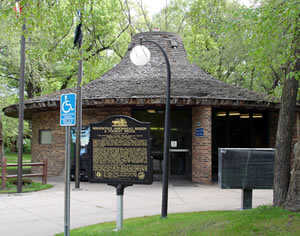
The Goose Creek Rest Area is located on northbound Interstate 35 in Chisago County, part of Mn/DOT's Metro District. Photo by the Office of Environmental Services |
I just would like to compliment the workers who keep these rest areas (the General Andrews rest stop, Goose Creek rest stop and Forest Lake rest stop) spotless, clean and who are friendly people…Since August I have been traveling to Duluth on a regular basis. Those rest stops are always clean and well-maintained and the gentlemen who work there are always friendly. Thanks for making my trips nicer.
Dale W.
I am a truck driver and was in the area so I stopped and visited your Welcome Center on Hwy 371 this Sunday evening (April 15) at approximately 9:30 p.m. I would just like to say I was very impressed with your facility. It was very clean, very organized and visually appealing. I have been to many different facilities throughout the country and I would have to say yours ranks among the best. I would also like to compliment the custodian on duty during my visit. He was very friendly and was helpful in giving me directions to a local business. Once again I would like to say thank you, and I plan on visiting your area again in the future with my family.
Truck Driver Joey
|
 |
|
| |
|



